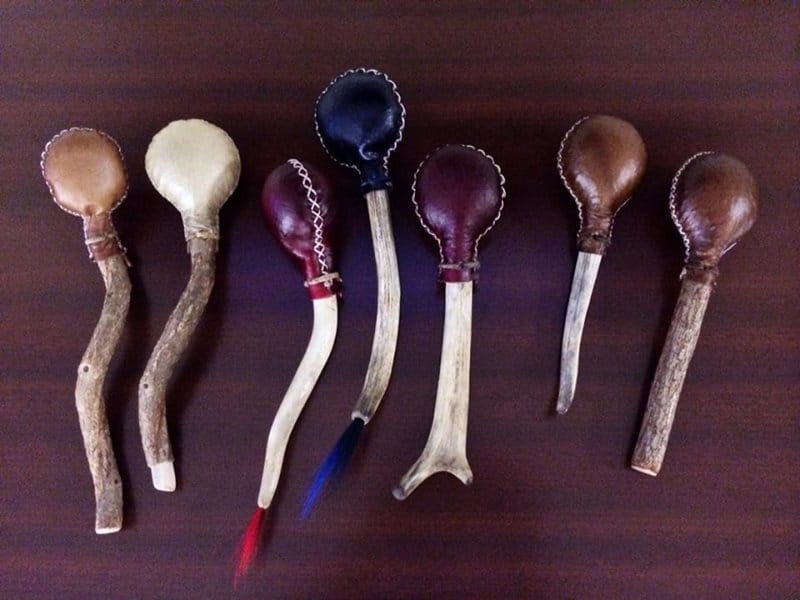Before the Creator formed the world, the sound of the shishigwen (rattle) filled the void with a steady rhythm. Many Potawatomi liken them with the ability to give life in Nishnabé tradition. Rattles imitate the resonance of water, ranging from sprinkles hitting the bark on a tree to a thunderstorm. It all depends on the materials used, the size of the container and the pieces that fill it.
“They all have a different look. They all have a different feel in your hand,” said Jason Wesaw, artist and Pokagon Band of Potawatomi citizen.

He began making rattles 15 years ago, and has gifted and sold hundreds in Potawatomi communities across the continent. Wesaw sticks to the style he developed through practice, and the possibilities keep the process enjoyable.
“I use anything from copper BBs to small little stones that I collect from the shoreline of Lake Michigan — just real tiny little stones,” he said. “You can also use things like beans or corn to fill in the shaker head of the rattle, and they’ll all give you a different sound.”
With a society founded on oral traditions, Nishnabé people utilize music as an essential part of ceremonies and social gatherings. Handmade rattles are one of the most common Potawatomi instruments with a rich history.
“Our songs originated out of prayer, out of communication to the Great Spirit, to Gzhemnedo,” Wesaw said. “And so that’s where drums and rattles have more of the importance in our traditional culture, where they come in is because they accompany our voice and singing those songs.”
Rattle making
Wesaw learned how to make drums from his grandfather who had a lifetime of experience in the craftwork. However, no one Wesaw knew made rattles, which left him to teach himself. He began studying them during a trip to Canada. Now, no two of his creations look the same.
“That might sound real simple. ‘Oh, yeah. It’s a rawhide rattle, and it’s attached to the handle.’ But within that, there’s limitless different combinations that you can do,” Wesaw said.
Wesaw’s rattle making instructions:
- Pick a medium to form the head.
“You can use a lot of different hides. You can use a deer hide, a cowhide. I prefer elk hide because it just has a really nice thickness, and it has a really nice, crisp sound.” - Dye the material for the head.
“That could be either commercial dyes, like a RIT Dye that you might find in a store, or you can go out and use natural dyes. That could be berries, could be different roots. There’s even a couple of different barks that you can use and just get really nice, rich, organic colors.” - Soak, cut and sew the rawhide.
“I soak the rawhide until it becomes soft and pliable. Then I have different patterns that I’ll set on the hide, trace them out and cut them out, and then I have to prepare it to be stitched. The rawhide is really tough, even when it’s wet and pliable. So I use a hole punch, and pre-punch the holes, and then I sew the rawhide up.” - Stuff the rawhide.
“When you stuff it, then all of a sudden, the rattle will take its shape. And so I stuff it enough to get the shape that I’m looking for, then I let it dry.” - Unstuff the head and fill it.
“Sometimes you can put a few little pebbles in there, and then we’ll have a real sharp sound. Sometimes you have to put a lot in there to get the sound that you’re looking for.” - Attach the head to the handle.
“You can have like a simple oak dowel handle, or I’ve used things like deer antlers. I’ve gone out and collected my own handles out of the forest and made them out of things like red willow, sassafras or maple.”
Wesaw sometimes looks at a few of his fabrications from before he fine-tuned his skills and found his style. Seeing them now, he feels less than impressed, but encourages all artists and craftspeople to keep creating.
“What it shows is that I’ve come a long way,” he said. “To continue to make stuff, you continually are refining it, finding better ways to make it, finding ways for it to look a little bit different than the last one, getting faster at making them. Whatever it might be, it’s all like a progression.”
Reconnecting
He now teaches around four rattle-making classes a year in different Indigenous communities. Wesaw enjoys passing on art forms used for thousands of years and inspiring his students to connect with their ancestors.
“You can’t really rescue our language and produce fluent speakers without people having a connection to our ceremonies. You can’t have ceremonies without a connection to our songs,” he said. “All these things are so interconnected that, you know, sometimes if a person makes a rattle or a drum, that’s kind of like their entryway back.”
Many rattle songs celebrate the time of day, such as the Morning Song, or pay tribute to mbish (water) or segmekwé (Mother Earth). Different events or occasions inspire each one, including some powwow songs. Crafting an instrument for personal use gives participation another layer of meaning, according to Wesaw.
“The most important part is when you do something yourself, whether it’s a rattle or a drum, making your own regalia, composing your own songs — anything that a person does themselves — they’re actually putting their own spirit into that work,” he said.
The Potawatomi Gift Shop carries a limited number of Jason Wesaw’s rattles and smudge bowls for sale at potawatomigifts.com.
